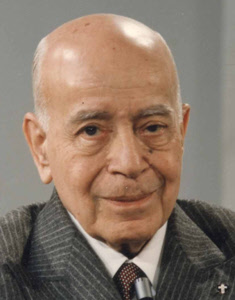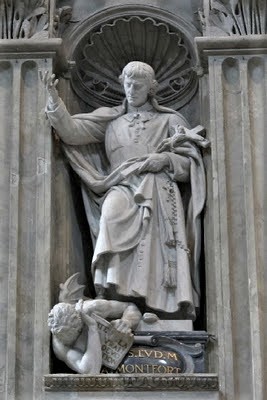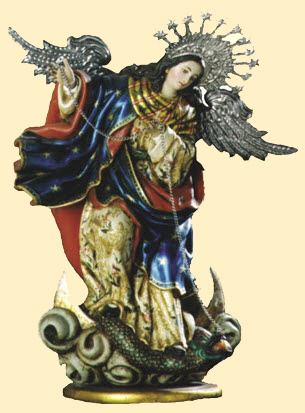
By Plinio Correa de Oliveira
We continue our series with Prof. Plinio Corrêa de Oliveira’s commentary on paragraph no. 261 from St. Louis de Montfort’s famous book Treatise on True Devotion to the Blessed Virgin. In the first part of the series we discussed doing all our actions “with Mary” and now we will discuss “in Mary”.
St. Louis de Montfort says:
We must do everything in Mary. To understand this we must realise that the Blessed Virgin is the true earthly paradise of the new Adam and that the ancient paradise was only a symbol of her.
There are in this earthly paradise untold riches, beauties, rarities and delights, which the new Adam, Jesus Christ, has left there. It is in this paradise that he "took his delights" for nine months, worked his wonders and displayed his riches with the magnificence of God himself. This most holy place consists of only virgin and immaculate soil from which the new Adam was formed with neither spot nor stain by the operation of the Holy Spirit who dwells there. In this earthly paradise grows the real Tree of Life which bore our Lord, the fruit of Life, the tree of knowledge of good and evil, which bore the Light of the world.
In other words, Adam, our first father, was created in paradise which was a place full of marvels, splendours and happiness. But he sinned and both he and Eve were expelled from paradise. But this was the paradise of the first Adam.
Our Lord Jesus Christ is rightly considered the new Adam. In other words, He came to restore humanity, to save it from the shadow of death and to restore it to the state of grace through His redemption, through is sacrifice of Himself on the height of the Cross. He is considered the new Adam and just as the first Adam was created in paradise, the new Adam should be created in paradise also.
So what was this paradise, this second paradise of the second Adam? It was Our Lady. That is, everything the first paradise—earthly paradise—had that was beautiful, splendid in its material reality, Our Lady also had what was beautiful and splendid in the spiritual realm. In fact it was even more splendid and beautiful that the first paradise.
While Our Lord Jesus Christ lived in Our Lady, He not only had all the joy and all the contentment that Adam had in paradise, but much more because, just as He is incomparably and infinitely superior to Adam, the second paradise of the second Adam was unfathomably superior to the first paradise of the first Adam.
Our Lady is then the Paradise of Our Lord Jesus Christ. This is the thought St. Louis is developing here. And the next considerations are based on this idea.
“There are in this earthly paradise untold riches, beauties, rarities and delights, which the new Adam, Jesus Christ, has left there.”
It is important to note that every St. Louis de Montfort says here is very precise. He makes a distinction between “riches, beauties, rarities and delights”. They are all different.
Riches is the abundance of useful things. This is different from beauty. Something can be of great beauty, but not represent richness. A good example is water. We can have a stream of crystalline water that has a great beauty. This water may even be—and certainly is—incomparably more beautiful that any tractor, which is something ugly. Nonetheless a tractor is a richness and water is a beauty.
In this new paradise, therefore, existed riches and beauties in the spiritual sense of the word. There were also rarities. You could say: “But what is rare is expensive”. This is true in our money-obsessed society where everything has a price, but not in a society without such an obsession, not everything that is rare is expensive.
For example, a true friend is becoming a rarity; but not because it is hard to find for sale. If a friendship needs to be bought or sold, it has ceased to exist.
Rarity is therefore different from the first two elements of beauty and riches. St. Louis made a calculation. He made an exact inventory of the various ways in which something could be worth something for man.
Then comes delights. A delight makes something amenable, pleasant to deal with, soft to the touch. To have an idea let us consider (I do not know if scientists have now been able to explain what I am about to say. But at least when I was a boy, they had no explanation) the well-being we feel when seated in the shade of certain trees.
Near the town of Amparo [in the state of São Paulo, Brazil] along the road there is a beautifully developed and rounded tree—it looks like a ball—that touches the ground. If I were younger, I would have stopped the car and stayed a while underneath the trees branches because I am sure one would feel a delight that is different from richness and beauty. This well-being comes from a cosiness, a harmony, a suavity that is different from other things. One can also feel this when next to water such as a beautiful lake, a stream or the sea. One need not even be touching the water. Indeed the sea has a sweetness—depending on the moment of course, because the sea also has moments of magnificent wildness. Everything in the sea is magnificent, except when it has been dirtied by the petrol of a passing ship. Otherwise, the sea is a marvel!

“… which the new Adam, Jesus Christ, has left there.”
Here we have the idea that Our Lord Jesus Christ, during the time He lived in Our Lady’s maternal womb, left all sorts of marvels within her. Then whilst He lived with her from His birth to His Ascension, He left even more marvels. In paradise Adam was a consumer—it is not written that he embellished anything—although it probably would have been his task, along with his descendants, to build a civilisation that would embellish paradise even more.
But Our Lord Jesus Christ embellished His paradise. In other words, he adorned Our Lady with indescribable graces. This is where we get the idea that the new Adam embellished substantially His paradise just as the human race, if it had not fallen into sin, would have embellished earthly paradise.
“…It is in this paradise that he "took his delights" for nine months, worked his wonders and displayed his riches with the magnificence of God himself.”
The magnificence of a God is total magnificence. St. Louis, with one phrase, reminds us how no one can do things as magnificently as God. And if this is true, then it is also true that the paradise of the new Adam was more splendid than the paradise of the first Adam. Hence Our Lady, spiritually speaking, was incomparably more beautiful that the whole universe.

In other words the stars, sun, moon, water, lilies of the field—whatever you like—cannot be compared to the beauty of Our Lady. Nor can these things be compared to her physical beauty either, because her physical beauty was a reflection of her transcendental moral beauty.
“… This most holy place consists of only virgin and immaculate soil from which the new Adam was formed with neither spot nor stain by the operation of the Holy Spirit who dwells there.”
Here we have another beautiful comparison. Just as Adam was formed from the earth by God Who then breathed in a soul, so also the new Adam was formed from the virginal flesh of Our Lady through the work of the Holy Ghost.
“… In this earthly paradise grows the real Tree of Life which bore our Lord…”
There was a tree of life in earthly paradise. But in the new paradise there is another tree that produces even more precious fruits: Jesus Christ. This is a fruit of the virginal fecundity of Our Lady.
to be continued...
(*) Britain Needs Fatima Members Newsletter is a publication of the Tradition, Family, Property Bureau for the United Kingdom.
Direct all enquiries to: Britain Needs Fatima, P.O. Box 2713, Glasgow, G62 6YJ
Tel: (0141) 956 7391 (0141) 956 7391 - Fax (0141) 956 6978 - editor@tfpuk.org.uk

No comments:
Post a Comment